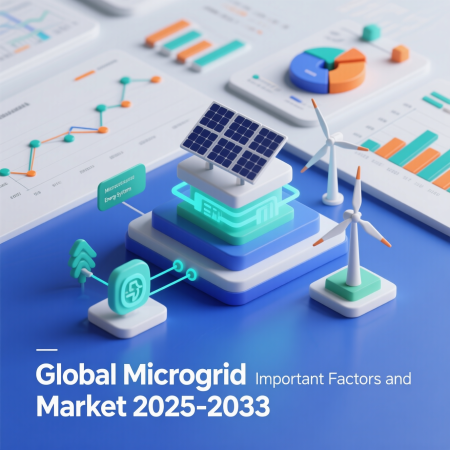Microgrid Market Outlook: Trends, Growth & Forecast to 2033

The global Microgrid Market reached USD 35.2 billion in 2024 and is projected to soar at a CAGR of 8.75%, reaching USD 79.6 billion by 2033. Fueled by rising demand for reliable, resilient power across utilities, campuses, defense installations, and remote systems, rapid adoption of renewable integration, smart grid tech, and growing regulatory support are propelling the market’s steady growth.
STUDY ASSUMPTION YEARS
- BASE YEAR: 2024
- HISTORICAL YEAR: 2019–2024
- FORECAST YEAR: 2025–2033
GLOBAL MICROGRID MARKET KEY TAKEAWAYS
- Global market value was USD 35.2 billion in 2024, rising to USD 79.6 billion by 2033, with a CAGR of 8.75%
- North America dominates, holding the largest share in 2024 with steady investments across energy-resilient systems
- Energy source segmentation led by Combined Heat and Power, followed by solar PV, natural gas, diesel, fuel cell, and others
- Applications include Remote Systems, Institution & Campus, Utility/Community, Defense, and Others, with remote systems commanding the majority share
- Asia Pacific and Europe also exhibit robust growth, driven by industrialization, grid modernization, and renewable mandates
- Technological advances in energy storage, AI-based controls, and integration of solar, wind, CHP fuel expansion
MARKET GROWTH FACTORS
1 - Growing Demand for Reliable and Resilient Power Infrastructure
Microgrids are increasingly in demand as the need for reliable and resilient power infrastructure grows, driven by factors like the increasing frequency of grid failures, aging grid infrastructure, the accelerating pace of renewable energy adoption, and the need for energy independence in critical facilities and remote areas. Extreme weather events are increasing in frequency and severity globally, highlighting the vulnerabilities of traditional centralized grids and emphasizing the need for a more robust and localized energy infrastructure.
2 - Decarbonization Efforts and Renewable Energy Integration
Microgrids are proving to be a key driver in the global effort towards decarbonization and the seamless integration of renewable energy sources into power systems. These localized, interconnected networks are crucial in addressing the intermittency challenges inherent in sources like solar and wind power, By combining renewable energy generation (e.g., solar panels, wind turbines) with advanced energy storage technologies (like batteries), microgrids can store excess energy during periods of high generation and release it when renewable output is low or demand is high, according to Novergy Solar. This reduces reliance on fossil fuel-based backup generators and allows for higher penetration of clean energy into the local grid, thus significantly lowering carbon emissions and contributing to cleaner air and a more sustainable energy future.
3 - Technological Advancements
Technological advancements, including the proliferation of advanced energy storage systems, sophisticated smart grid technologies, and the integration of Artificial Intelligence (AI) and the Internet of Things (IoT), are revolutionizing the microgrid landscape. The increasing efficiency and declining cost of energy storage solutions, particularly advanced battery chemistries like lithium-ion and solid-state batteries, enable microgrids to store excess renewable energy and provide power during periods of low generation or grid outages, thus enhancing reliability and resilience. Smart grid technologies, characterized by advanced sensors, automation systems, and real-time data analytics, empower microgrids with enhanced monitoring, control, and optimization capabilities for managing energy generation, consumption, and distribution efficiently and reliably. Furthermore, Artificial Intelligence and Machine Learning algorithms are playing a pivotal role in optimizing microgrid operations through more accurate forecasting of energy demand, predictive maintenance of equipment, dynamic load balancing, and enabling automated decision-making during grid disturbances.
Request for a sample copy of this report:
https://www.imarcgroup.com/microgrid-market/requestsample
MARKET SEGMENTATION
Breakup by Energy Source
- Natural Gas – microgrids powered by pipeline or local gas networks
- Combined Heat and Power – integrated systems generating both electricity and thermal energy
- Solar Photovoltaic (PV) – solar panels linked with storage and controls
- Diesel – backup generators using diesel fuel
- Fuel Cell – hydrogen or other fuel‑cell-based power units
- Others – additional energy sources not categorized above
Breakup by Application
- Remote Systems – off-grid or isolated microgrids serving remote areas
- Institution and Campus – systems deployed at educational and corporate campuses
- Utility/Community – utility-owned or community-scale microgrids
- Defense – military installations and defense infrastructure microgrids
- Others – various end-use applications beyond core categories
Breakup by Region
North America (United States, Canada)
Asia Pacific (China, Japan, India, South Korea, Australia, Indonesia, Others)
Europe (Germany, France, United Kingdom, Italy, Spain, Russia, Others)
Latin America (Brazil, Mexico, Others)
Middle East and Africa
REGIONAL INSIGHTS
North America currently dominates the global microgrid market, driven by robust infrastructure investment, rising weather-related outages, and strong policy support. In 2024 North America held the largest share and is projected to grow from USD 14.9 billion to USD 36.2 billion by 2033 at a CAGR of 9.87%. Energy resilience demands across critical installations and widespread adoption of renewable‑based microgrids are bolstering regional performance.
RECENT DEVELOPMENTS & NEWS
Recent trends show increased deployment of hybrid microgrids combining solar PV, CHP, batteries, and emerging fuel‑cell solutions. IMARC highlights remote systems and defense applications as fast-adopting segments, leveraging new digital control tech to enhance reliability. Government initiatives - such as AI‑enabled interconnection funding - are accelerating project timelines and reducing regulatory barriers in key markets like the U.S., boosting both public and commercial installations. These advances reflect a growing shift toward resilient, sustainable and smart microgrid solutions globally.
KEY PLAYERS
ABB Group, Bloom Energy, Eaton Corporation plc, GE Grid Solutions, LLC, Hitachi, Ltd., S&C Electric Company, Schneider Electric, Siemens AG, etc
Ask Analyst for Customization:
https://www.imarcgroup.com/request?type=report&id=883&flag=C
If you require any specific information that is not covered currently within the scope of the report, we will provide the same as a part of the customization.
About Us:
IMARC Group is a global management consulting firm that helps the world’s most ambitious changemakers to create a lasting impact. The company provides a comprehensive suite of market entry and expansion services. IMARC offerings include a thorough market assessment, feasibility studies, company incorporation assistance, factory setup support, regulatory approvals and licensing navigation, branding, marketing and sales strategies, competitive landscape, and benchmarking analyses, pricing and cost research, and procurement research.
Contact Us:
IMARC Group
134 N 4th St. Brooklyn, NY 11249, USA
Email: sales@imarcgroup.com
Tel No:(D) +91 120 433 0800
United States: (+1-201971-6302)






